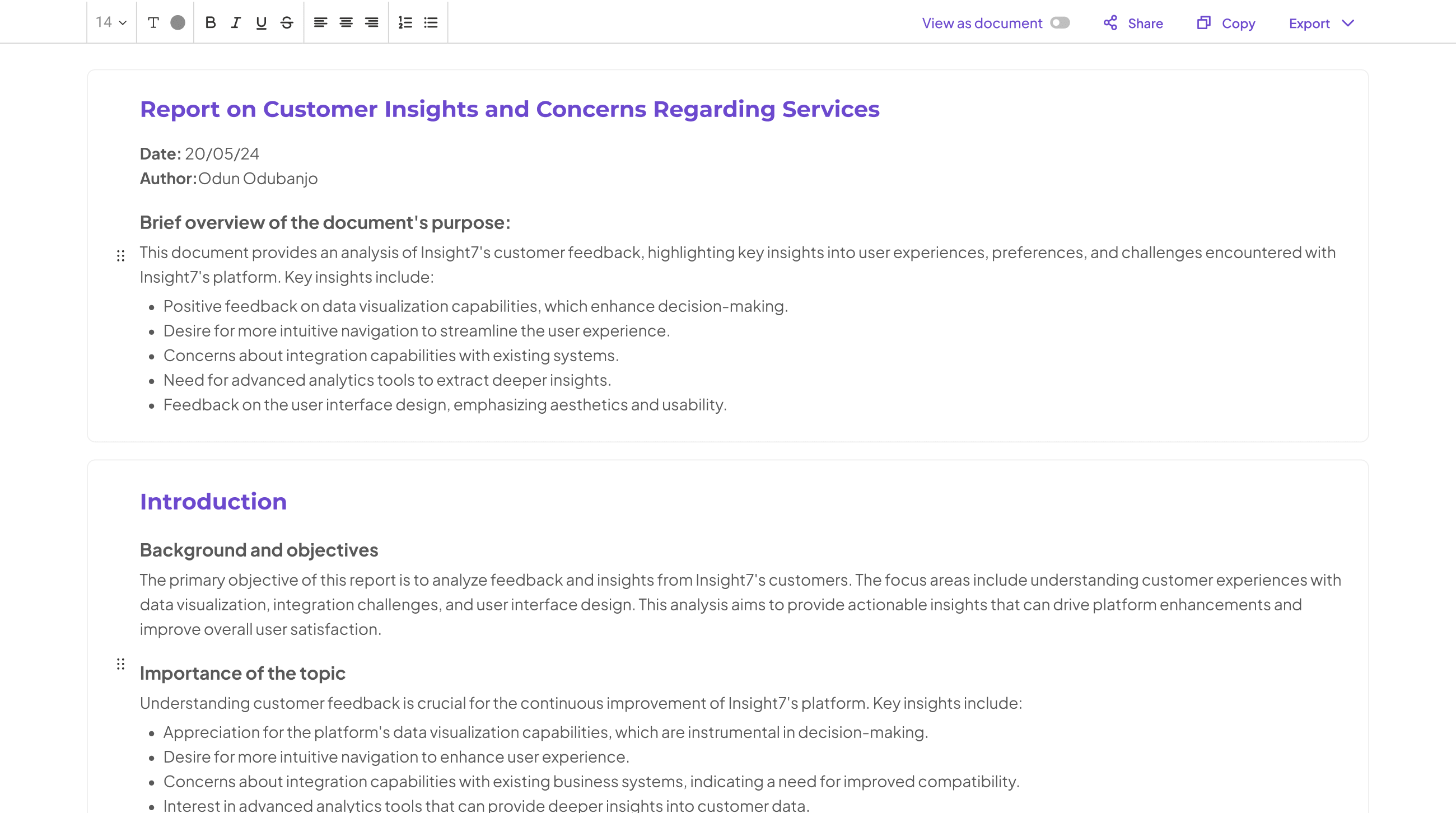Research Report PowerPoint Presentation: How to Create
-
Bella Williams
- 10 min read
A clear and engaging presentation can make all the difference in conveying the essence of your research. The Research Presentation Guide serves as a vital resource for anyone seeking to create compelling PowerPoint slides that effectively communicate their findings. Presenting data is not merely about displaying numbers; it’s about narrating a story that resonates with your audience.
Understanding your material is crucial. This guide will help you structure your slides while emphasizing critical insights that clarify your research outcomes. By focusing on key ideas and visual storytelling, you can ensure that your audience comprehends complex information with ease and retains what matters most.
Transcribe & extract insights from interviews. At Scale.

Designing an Effective Research Presentation
Designing an effective research presentation involves several essential elements that can significantly enhance how your audience perceives and engages with your work. First, clarity is crucial; your slides should convey information straightforwardly and succinctly. Utilizing visuals such as charts, graphs, or images can make your data more relatable. When presenting, ensure you maintain a logical flow that guides your audience through your findings. This will help them better understand the context and implications of your research.
Additionally, consider your audience’s needs and preferences when designing your research presentation. Tailoring your content to address their interests can foster a more interactive experience. Use a consistent color scheme and font style to create visual coherence across your slides. Remember, practicing your delivery is key to fostering confidence and ensuring you effectively communicate your message. Following these guidelines will enable you to create an impactful and engaging presentation that resonates with your audience.
Research Presentation Guide: Structure and Flow
A solid Research Presentation Guide emphasizes a clear structure and flow to ensure the audience remains engaged. Begin with a strong introduction that outlines the key points of the research. This sets the tone, allowing listeners to grasp what to expect. The body of the presentation should logically progress, with each slide building on the previous one. Utilize visuals effectively to support your arguments and maintain the audience’s interest.
To enhance flow, include transitions that connect different sections smoothly. For example, summarize key findings before moving on to recommendations. Conclude with a compelling summary that reinforces the main ideas and invites questions. This approach not only clarifies your research but also boosts audience retention. Ultimately, the success of your presentation hinges on how well you guide your audience through your narrative, making the Research Presentation Guide an essential tool in creating impactful presentations.
Visual Design Principles for Engaging Slides
Engaging slides are grounded in visual design principles that enhance comprehension and retention. Simple, clean layouts facilitate the audience’s focus on the message, making it critical to eliminate clutter and distractions. Use contrasting colors to ensure readability and guide attention toward key points. An effective color palette can also evoke emotions, enhancing the overall narrative of the presentation.
Incorporating images, infographics, and minimal text can amplify engagement. Visuals break the monotony of text-heavy slides and can illustrate complex concepts more effectively. Be mindful of the font choice and size; clear, legible typefaces can significantly impact audience understanding. Additionally, maintaining a consistent design theme throughout the presentation builds coherence and professionalism, ensuring that all elements work harmoniously together. By employing these visual design principles, you can create a compelling Research Presentation Guide that not only informs but also captivates your audience.
Generate Detailed Reports from Your Qualitative Data in Minutes.
Key Elements of a Successful Report Presentation
A successful report presentation requires clarity, engagement, and organization. First, a strong opening sets the stage for the audience, capturing their attention with a compelling introduction. Ensure your key findings are clearly outlined, allowing the audience to grasp the core message quickly. Visual aids, such as graphs and charts, enhance understanding and retention of complex data.
Next, a logical structure helps guide the audience through your presentation. Start with the background to provide context, followed by the methodology, findings, and implications. Each section should flow seamlessly into the next, maintaining audience interest throughout. Ending with a clear conclusion and a call to action reinforces your main points and encourages further discussion. In essence, a well-crafted report presentation not only conveys essential information but also invites engagement and response from the audience.
Research Presentation Guide: Content Development
A well-crafted Research Presentation Guide is essential for effective content development. Start by understanding your audience and tailoring your presentation to their preferences and knowledge levels. This approach ensures that your findings are relatable and engaging, fostering a connection with your listeners. Furthermore, it’s vital to focus on the key messages you wish to convey. Identifying these core ideas enables you to create a captivating narrative that resonates throughout your presentation.
In addition, incorporate visuals, such as graphs and charts, to complement your oral delivery. Visual elements can illustrate complex data, making it easier for your audience to grasp essential points. Organize your slides logically, following a structure that outlines the problem, presents your findings, and offers actionable recommendations. This flow not only guides your audience but also reinforces the significance of your research, leaving a lasting impression. Remember that clarity and engagement are your primary goals in any research presentation.
Tips for Delivering with Confidence
Delivering a research presentation with confidence can significantly enhance the impact of your findings. Start by knowing your content thoroughly; this ensures you can articulate ideas clearly without relying too heavily on notes. Practice your delivery multiple times, focusing on maintaining a steady pace and clear pronunciation. Additionally, visualize yourself presenting successfully. This mental rehearsal can build your self-confidence and reduce anxiety.
During your presentation, engage with your audience by making eye contact and inviting questions. This interaction not only fosters connection but also shows your passion for the topic. Use body language effectively to emphasize key points, and remember to breathe deeply to help calm your nerves. Following these tips will make your research presentation more dynamic and compelling, allowing you to convey your ideas powerfully.
Conclusion: Mastering the Research Presentation Guide
A successful conclusion in your research presentation emphasizes the importance of synthesizing key insights and recommendations. By mastering the Research Presentation Guide, you ensure your audience leaves with a clear understanding of the research findings and their implications. This clarity can drive decisions and inspire action while placing your research in a practical context that resonates.
Transcribe & extract insights from interviews. At Scale.

In navigating the complexities of your research, remember that effective storytelling plays a vital role. Wrap up your presentation by highlighting the main themes, addressing potential follow-up questions, and encouraging further discussion. This not only elevates your work but also fosters engagement, making your presentation memorable and impactful.







